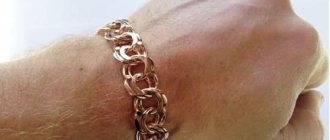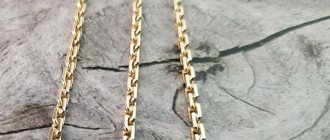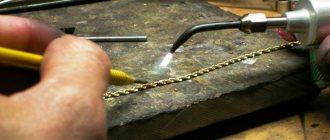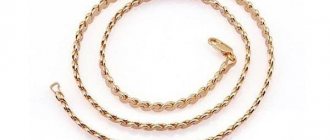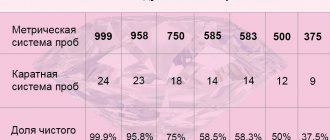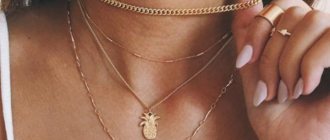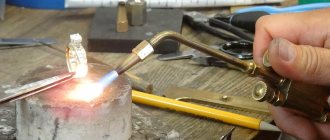There are dozens of weaving methods and technologies for their production in the world. And they differ not only in appearance - some are super strong, others are flexible, and the links of others are woven into flowers. Some can only be done by hand, while others can only be done by machine. We have collected the most popular types of weaving and told you the difference between machine and hand knitting, as well as about hollow and full-weight chains.
Hollow and solid chains
If you take a hollow chain in one hand and a full-weight one in the other, you will immediately understand the difference - the first, for all its volume, will be much lighter than the second. If you look at a hollow chain in cross-section, it will look like a tube because it has voids in the middle. The full weight chain is completely cast from metal.
A hollow chain will look more massive and larger than a full-weight one, and its price will be lower. However, such a product is easier to bend or deform, so it requires careful care - take it off at night, do not wear it during sports activities, and protect it in every possible way from physical impact.
The full weight chain is durable. It will not bend, and will withstand even heavy pendants with dignity (but: here you need to take into account the weight ratio of the chain and pendant). However, due to the weight, you will have to pay more for such a product.
Gold chain heart
The core of the hollow chain can be low carbon steel, brass, copper or aluminum. Steel is used for the production of low-grade products - 385 or 585 red gold. Iron easily dissolves when etched with a 25–50% hydrochloric acid solution. After 3–15 hours, not a trace remains of the steel core in the chain. However, the characteristics of iron are very different from those of gold, which creates certain difficulties in machining and soldering.
Brass or copper behaves more like gold. They are recommended for yellow precious metals of a higher standard. Such a core is etched with nitric acid. Aluminum cores are used in the manual production of complex woven hollow chains. Aluminum is etched using caustic soda.
The final steps in making a hollow chain are to apply the diamond edge, which makes the jewelry shine, and attach the lock links.
Machine or hand knitting chains
Machine knitting technology is good for both the thinnest and lightest chains and popular full-weight weaves. Moreover, most light chains that are knitted on a loom cannot be made by hand due to their very small size or complex assembly.
With the help of machinery, it is possible to produce a full-fledged product of 1 gram or less, and the smallest link size in our factory, for example, will be 1.4 mm. Once the decoration is woven, it is sent to an oven heated to 815 degrees to join the ends of the links. This is how we get perfectly smooth products with identical elements.
Our customers often ask about the strength of weaves. So, in terms of strength, machine and hand knitting are not inferior to each other. Strength often depends on the thickness of the wire, the quality of soldering of the links and, of course, the careful wearing of the jewelry affects it.
Chain tying machine creates 600 links in 1 minute
Hand weaving allows you to make a really strong chain that will be good for everyday wear and large pendants. In addition, in this way you can realize any idea - come up with a fancy weave for one single order, combine it with cast elements. The manual method of weaving chains requires a lot of time and the professionalism of a specialist. See for yourself - on average, the process, from working with wire to obtaining the finished product, goes through 13-14 stages.
Technological features of weaving
There are several weaving methods that allow you to create unique jewelry:
- Machine knitting is performed on modern equipment and is based on process automation. The latest technology makes it possible to weave jewelry whose links are less than a millimeter thick.
- Handwork is used in the manufacture of types of weaving that cannot be done on a machine. The minimum weight of handmade chains is from 6 grams. The impeccable quality of workmanship is determined by the degree of professionalism of the chain jeweler. The painstaking weaving of jewelry chains consists of winding gold or silver wire around a workpiece and cutting it into rings of the same size. The links are compressed using pliers. The connector of each link is soldered. Labor-intensive work is highly valued.
- The stamped chain is assembled from blanks. The links are threaded into one another without soldering. The finished decoration may become deformed, twisted and less durable.
Most popular chains
This weaving was invented for heavy chains weighing more than 100 grams, but it turned out to be too beautiful and practical to remain aside. So this method began to be used for the production of thin light chains. It can be made either manually or using machinery. By the way, Bismarck weaving is especially popular in Russia.
This weaving is often called “Byzantine” and “Royal” - and all options are correct. The ornate interweaving of rings makes it one of the most beautiful and feminine weaves. Of course, this also affects the strength - such a chain will withstand heavy pendants.
Fox tail chain weaving is often equated to Byzantine chain weaving. But even at first glance, the difference is striking. “Fox tail” - weaving is more smooth and dense. Its links fit into a strong chain like a puzzle. A thick chain of this type of weaving cannot be broken by hand.
You can guess its name from the appearance of the chain. Weaving differs sharply from others in the fastening of the links - in a “rope” they are tightly connected to each other and twisted with a rope. This feature makes the chain strong and allows you to wear heavy pendants and crosses. At the same time, it turns out to be so self-sufficient and elegant that it can be worn without additional pendants.
The exceptionally feminine Rose or Courage weave is impressive. Its details in the form of buds are made not of simple links, but of spiral ones. Due to this design, the chain looks voluminous and airy, but in fact has good strength.
“Caprice” or “Python” is another type of durable weaving. Most often it is done manually. It is one of the few chains that can be worn independently without additional accessories. Beautiful, laconic, airy.
Weaving "Nonna" is very popular among female buyers. It looks openwork thanks to the connection of lines and harmoniously combines with various pendants. Due to its design, it can be worn as a stand-alone piece of jewelry. Remember that it all depends on the diameter and thickness of the chain wire. This weaving often refers to machine knitting; less often, craftsmen assemble the links by hand. Reliable, beautiful, affordable - despite the fact that weaving is a classic on the shelves of jewelers, the Nonna chain is still relevant to this day.
Diamond, double or triple diamond - these types of chains are popular among both men and women. Based on the name of the weave, the design is based on a diamond shape. Several types of weaving allow you to make the chain both laconic and more massive and voluminous. It is made both manually and by machine, and therefore is available to a wide range of buyers.
A classic and universal version of weaving - it does not stand out as pretentious, suitable for both men and women. The rounded elongated links are connected in series and perpendicular to each other. It was invented back in Ancient Egypt, and it became the basis for dozens of other types of weaving. It is performed both manually and using automated equipment.
Simple and straightforward weaving with perfectly round links. It can also be found under the names “Belzer” and “Chopard”. The latter stuck with him because of Chopard’s love for this weave - the brand actively used it for many years and made it its calling card.
“Snake” is ideal for everyday wear - laconic, stylish, versatile and as strong as a lace. But such a chain must be worn especially carefully and removed at night. With physical impact, creases form on it.
Singapore weave has a complex spiral structure. It gives the chain a graceful shine as it moves. Pairs with almost any style and jewelry.
Gurmet weaving is universal and elegant at the same time. It consists of small links that form an elegant chain. “Gurmet” is good not only on the outside, but also on the inside - such a chain does not twist and serves faithfully for a long time.
The “Chris Cross” chain is a fancy weave, complex and extraordinary in shape, but in every sense a brilliant know-how among different types of chains. It looks impressive, stylish, bright, like a rich, self-sufficient necklace. It appeared on the shelves of jewelry stores relatively recently, but has confidently taken its place among the popular models.
How to check whether it is gold or not?
To check the authenticity of gold, take a powerful, high-quality magnet. Place a magnet on the gold you want to test. If it is attracted to a magnet, it is not quality gold or not gold at all. It can be either low-grade (10 carats) or just a gold-plated product in front of you.
Interesting materials:
What should you try in your entire life? What is the economic sphere of public life? How to respond to the message How is life? What did Stolypin's reform change in the lives of peasants? What is the spiritual sphere of social life? What is an individual lifestyle? What is a lifestyle? What is a lifestyle? What is society in the sphere of public life? What is a life reset? What is the fruit of life in The Sims 3?
